

Autumn Speyside Whisky Festival Report and Tour in the Highlands, September 27th-October 04th, 2009
Day 7 and 8:
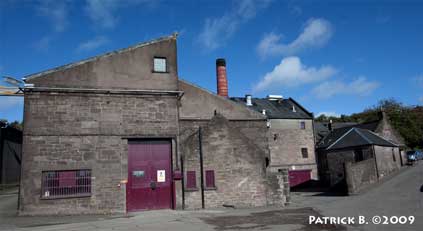 |
| Glencadam distillery. |
I left GlenDronach in the early morning to drive South to Brechin for the visit of the Glencadam distillery.
Glencadam is the last distillery in Angus, with Glenesk/hillside replaced by the Greencore maltings (the warehouses are still standing), Lochside was burnt down and very promptly replaced by a residential area, and North Port/Brechin replaced by a supermarket, with only 1 wall left as a vestige. To reach the distillery, I drove past the municipal cemetery and with its dark modern concrete buildings. The first impression of Glencadam is rather gloomy; a contrast to GlenDronach. However, I was warmly welcomed by Mr Wilson, the distillery manager, who guided me through his modern and compact distillery. The production is currently of 1 mio LPA, with a maximal capacity of 1.4 mio LPA and since the warehouse are now almost full, they have just reduced from 7 days to 5 days of work per week. The still house is very compact, with limited expansion capacities. The wash still is quite unique at Glencadam, since no internal (direct or indirect fire) is used to heat the content of the still. Instead, the wash is pumped into an external heat-exchanger and re-injected (sprayed) back into the wash still close to boiling temperature. According to Mr Wilson, this system is highly energy efficient.
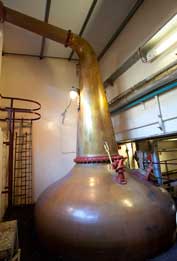 |
| The wash still at Glencadam. |
On site, Glencadam has also a blending facility, which unfortunately could not be visited. Before leaving, I could taste the Glencadam 15 YO, a nice dram, quite oily and heavy, more a Highland than a Speyside whisky. Hopefully, the new packaging will allow this whisky to reach a better visibility.
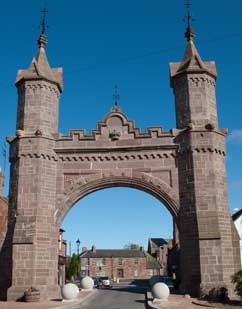 |
| The Ark at Fettercairn |
After a lunch at the new organic café in Fettercairn, I went to my last distillery visit: Fettercairn distillery. As for Glencadam, Fettercairn is one of the low profile distilleries, known only by a few whisky enthusiasts.
 |
| Fettercairn distillery |
Fettercairn is a nice looking distillery, with its pagoda and white washed walls. In company of Dave Doig, the distillery manager, I was shown through the distillery. The distillery is rather spacious and the spirits stills feature a unique device, allowing a thin stream of water running done the neck of the still in order to increase the reflux. In addition, the heat recovered by the water warmed by the hot copper stills is re-used via a heat exchanger.
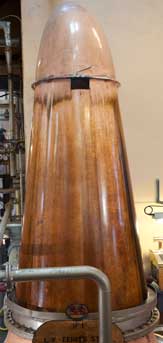 |
| The water cooling system for the neck of the spirit still. |
Dave Doig has also been active in the re-opening of the Tamnavulin distillery 2 years ago. I was informed that the old cast iron have not been replaced, however, the whole set of stills with the flat bottom (wash stills) had to be changed. With a capacity of 3.7 mio LPA, Tamnavulin is now the largest malt distillery of Whyte & Mackay. In addition, the style of spirit has been modified to make it heavier in style.
To come back to Fettercairn, I was informed that the production of heavily peated malt (55 ppm) started at the same time as in Dalmore, thus 4 years ago.
A comparison between the non-peated and peated Fettercairn was interesting. In addition, I was served with a 4 YO heavily peated Fettercain matured in a first fill bourbon cask. The result was quite impressive in terms of quality, maturity and complexity. As compared to some Islay whisky of the same age, the peat does not come as a blast, but it is released slower, associated with floral and fruity notes, and without showing the sweet-sugary aromas often detected in very young whiskies. I would be keen in tasting this whisky in 2-3 years. Hopefully, by then, a small batch of this heavily peated whisky will be released. The next whiskies tasted where two samples of the same year, one taken before and one taken after the stainless condensers where replaced by the new copper ones. To my opinion, the whisky distilled after the installation of the new copper tubes showed a significant improvement, less rough.
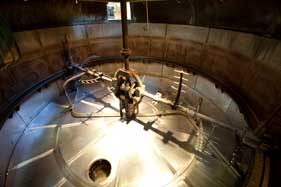 |
| The mash tun of Fettercairn distillery |
Afterwards, I could taste the new bottling done for the visitor center. Since they wanted to offer something different than the previous bourbon or sherry casks previously for sale, this one has been matured initially in a bourbon cask before being reracked in a sherry quarter cask. The result is a superb whisky, one of the best I tasted this year, with a perfect balance between the smoothness, the fruits and the floral notes, with quite some spiciness. I have not tasted the earliest single cask for sale at the distillery, but this one was stunning. The last dram I was offered was from an ongoing experiment, with a 45 YO Fettercairn matured in an American sherry cask, reracked in a quarter cask and then into a bourbon cask. A very good sherry wood, with the woody influence well contained for its age. I was also shown the maquettes of the new Fettercairn bottlings (a 24 YO, 30, and 40 YO), which should be released around Christmas as part of their new "Super-Premium Range". The price should be in the same range as the Dalmore or Isle of Jura equivalents. Considering the absence of marketing of Fettercairn single malt, this will not be an easy challenge for Richard Patterson and the marketing team.
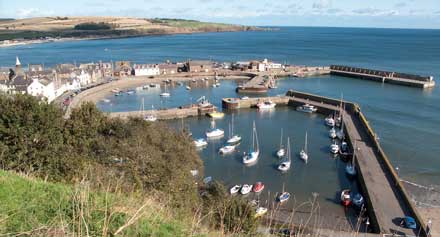 |
| The old harbour of Stonehaven |
After a visit at the old harbour of Stonehaven and the nearby Dunnotar castle, I flew back home, after some shopping at the Aberdeen and London Heathrow, where the new Dalmore 18 and Scirius were for sale, as well as the new Glen Garioch founder's reserve, Bowmore 21 YO cask strength Port Matured, Auchentoshan 1999 Bordeaux finish, and the new Port Ellen Doulgas Laing Platinum and Provenance, exclusive for World of Duty free.
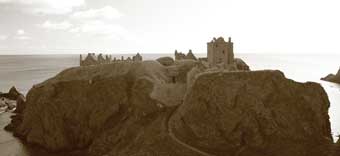 |
| Dunnotar Castle |
In addition, during this week, I learned that the production had been reduced at Balvenie and production stopped for some months at Kinninvie to compensate for production at the new Grant's distillery of Ailsa bay.
As you might imagine, this week was very intense, but also one of my best whisky experience in Scotland. I came back full of unforgettable memories, met formidable and enthusiastic Whiskymen. I wish to very much thank all the distillery managers and staff that I met during these 7 days, the people who helped me in organizing these visits, as well as the Dufftown 2000 team for organizing the Speyside whisky festival, a festival of human dimensions.
Slainte Mhath
Patrick
Patrick B. © 30 Oct 09